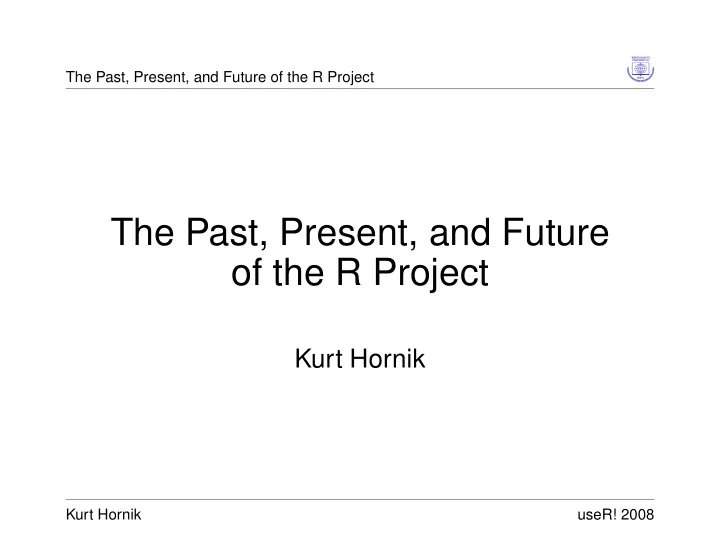

The Past, Present, and Future of the R Project The Past, Present, and Future of the R Project Kurt Hornik Kurt Hornik useR! 2008
The Past, Present, and Future of the R Project Prehistory of R: S v1 1976–1980 Honeywell GCOS, FORTRAN-based v2 1980–1988 Unix: macros, interface language 1981–1986 QPE (Quantitative programming environment) 1984– general outside licensing, books v3 1988–1993 C-based, S functions & objects Blue 1991 Classes & methods, statistical models White 1992 Performance improvements v4 ??? Programming with data Green Next book by John Chambers: “Software for Data Analysis: Programming with R” Kurt Hornik useR! 2008
The Past, Present, and Future of the R Project 1998 Association for Computing Machinery (ACM) Software System Award to John M. Chambers, the principal designer of S, for the S system, which has forever altered the way people analyze, visualize, and manipulate data . . . S is an elegant, widely accepted, and enduring software sys- tem, with conceptual integrity, thanks to the insight, taste, and effort of John Chambers. Kurt Hornik useR! 2008
The Past, Present, and Future of the R Project R history: Early days In 1992, Ross Ihaka and Robert Gentleman started the R project in trying to use the methods of LISP implementations to build a small test-bed which could be used to trial some ideas on how a statistical environment might be built. S-like syntax motivated by both familiarity and similarity to Lisp: parse(text = "sin(x + 2)") ⇔ (sin ("+" x 2)) Kurt Hornik useR! 2008
The Past, Present, and Future of the R Project R history: R Core First binary copies of R on Statlib in 1993 First release of sources under GPL in 1995 Many people started sending bug reports and helpful suggestions Formation of an “R Core Team” who collectively develop R, first official release by R Core: R 0.60 on 1997-12-05 Currently 19 members, including John Chambers First R Core meeting at DSC 1999 in Vienna R Core ⇒ R Foundation Kurt Hornik useR! 2008
The Past, Present, and Future of the R Project R milestones R 1.0.0 released on 2000-02-29 (once every 400 years): R as a reference implementation of S3 R 2.0.0 released on 2004-10-04: R as a reference implementation of S4 (connections, methods) and substantially beyond (name spaces, grid/lattice, Sweave, . . . ) Workings towards R3: i18n/l10n (”‘R learns to speak your language”’), graphics device drivers, 64 bits, object system and name spaces, perfor- mance enhancements, . . . Kurt Hornik useR! 2008
The Past, Present, and Future of the R Project But where is R really going? Wrong question. Applying Theorem 7 of Wittgenstein’s Tractatus Logico-Philosophicus: no answer. Kurt Hornik useR! 2008
The Past, Present, and Future of the R Project R base and extensions R Core provides a “base system” only. Even key statistical functionality available via contributed extensions (“packages”), some recognized as recommended and to be made avail- able in every binary distribution of R R distribution: R interpreter (plus tools) plus • Base packages: base, stats, graphics, methods, . . . • Recommended packages: MASS, boot, nlme, survival, . . . Two-or-more-tier development model Kurt Hornik useR! 2008
The Past, Present, and Future of the R Project R packages R extensions come as “packages” containing • meta-information, currently serialized as DESCRIPTION file in Debian Control File format (tag-value pairs) • code and documentation for R • foreign code to be compiled/dynloaded (C, C++, FORTRAN, . . . ) or interpreted (Shell, Perl, Tcl, . . . ) • package-specific tests, data sets, demos, . . . Kurt Hornik useR! 2008
The Past, Present, and Future of the R Project The key things to note are: • Packages have meta-data, including license, version (so that we know when they’re out of date), and internal and external dependencies • Package can contain “anything” • R knows a lot about taking advantage of what they contain (but there is always room for improvement) Meta-packages, frameworks, compendia, . . . The package system is one of the cornerstones of R’s success. Kurt Hornik useR! 2008
The Past, Present, and Future of the R Project So where is R going? Multi-tier development model: “R” as in “base R” or the “R Multiverse”? Base R developed by R Core: collection of individuals who work on stuff they need and/or like to work on. Some trends and open issues: large data sets, object systems, event loops, byte compiler, . . . Mostly unrewarding: “statisticians” do not get academic credit for working on such tasks. The R Foundation could hire programmers, but has not (yet?) There is no real project management. But what do people really need to be added to or changed in base R? Kurt Hornik useR! 2008
The Past, Present, and Future of the R Project The future of R Really need to consider contributed packages Packages come in repositories, with CRAN, Bioconductor and Omegahat the “standard” ones In what follows, we focus on CRAN (the CRAN package repository) Possibly substantial bias from focussing on standard repositories (ignores R stuff distributed in different ways) What is the number of CRAN packages? Kurt Hornik useR! 2008
The Past, Present, and Future of the R Project CRAN growth in the past Look at the time series of packages available on CRAN. Not entirely straightforward because there is no real transaction logging. Proxies: older talks by myself, numbers of binary packages for older ver- sions of R. E.g., sometimes mid 2002 (article “Vienna and R: Love, Marriage and the Future”, talk at GRASS 2002): 165–170; mid 2004 (article “R: The next generation” for COMPSTAT 2004): more than 300, mid 2005 (article “R Version 2.1.0” for Computational Statistics): about 500, mid 2007 (talk at Rmetrics 2007): close to 1100. Analysis based on the mtimes of package/bundle files on the CRAN mas- ter. May be imprecise for the early days; should be rather reliable since the advent of R News. Kurt Hornik useR! 2008
Recommend
More recommend